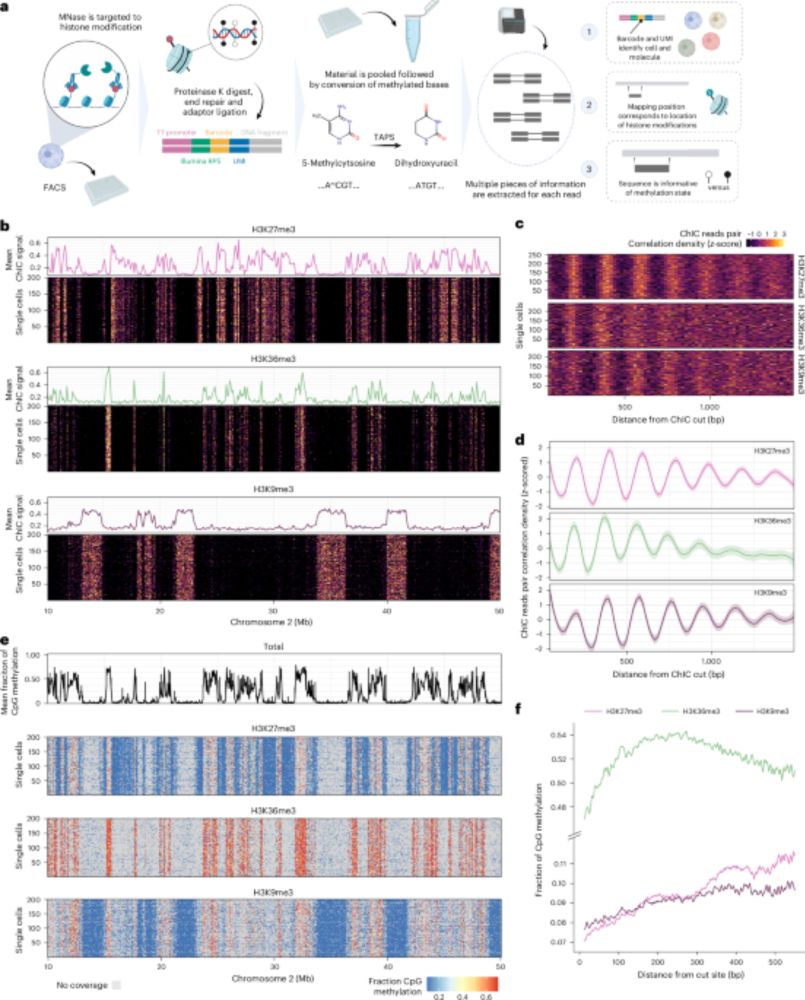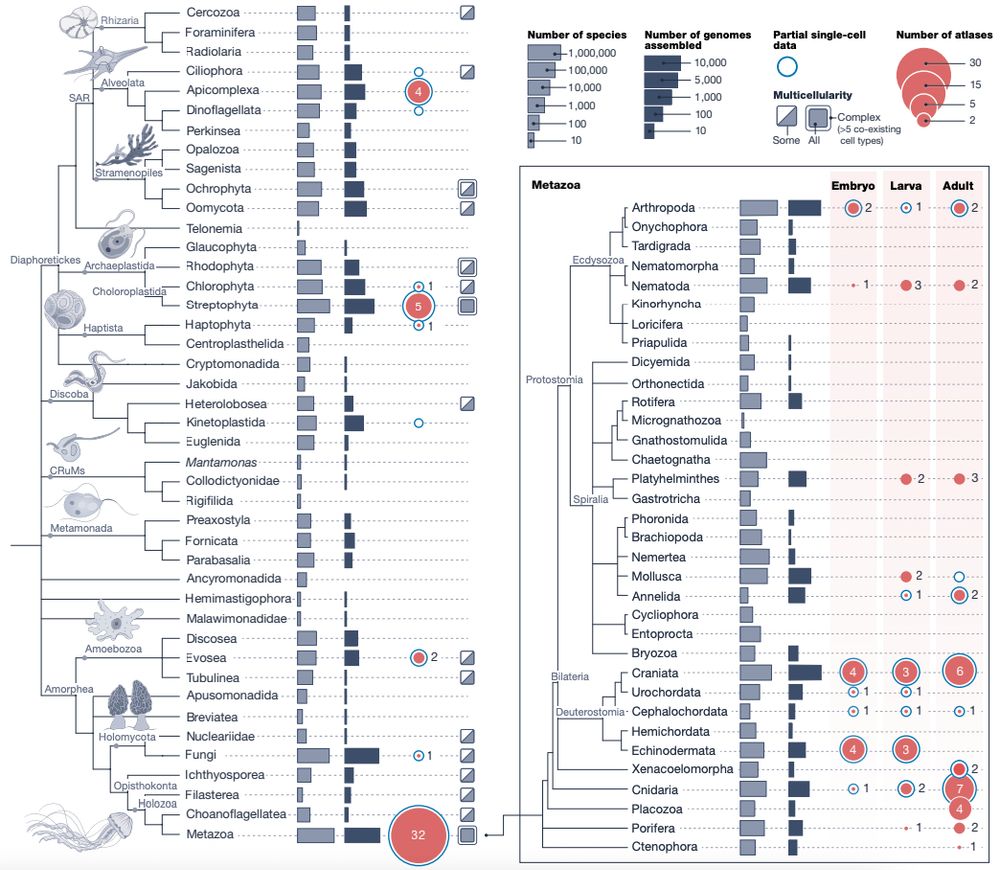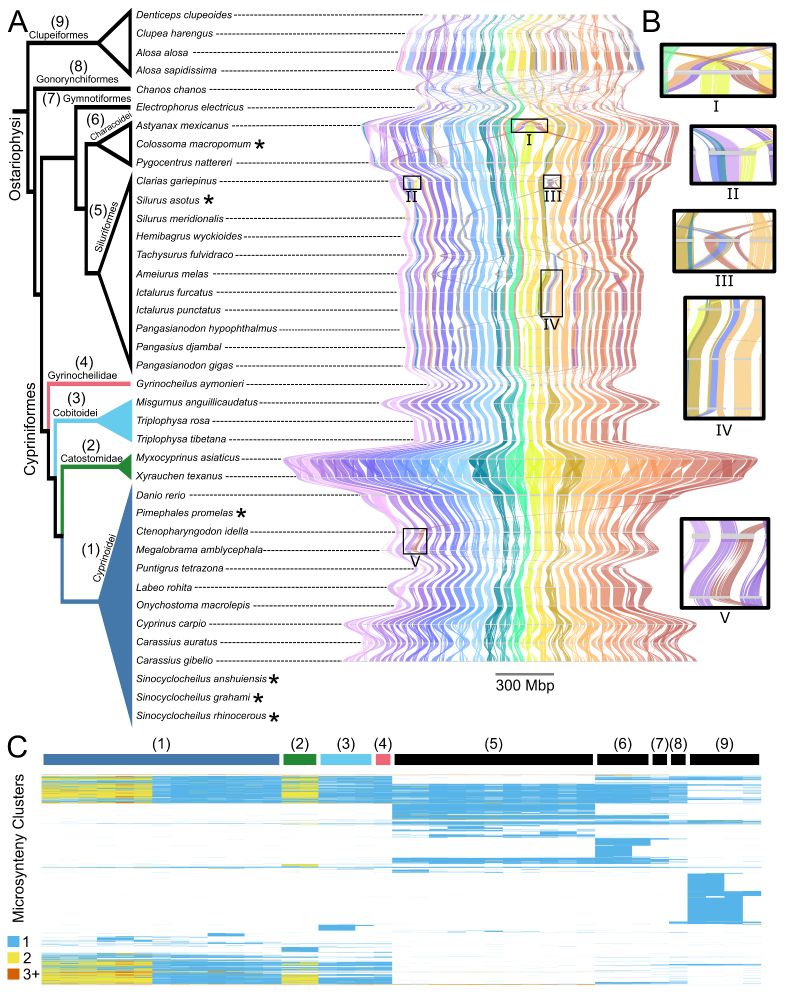
Cecile Lorrain
@ccilelorrain.bsky.social
SNSF Ambizione Fellow | Junior PI in Plant Pathology @ ETH Zürich | Specializing in fungal genome architecture & TE-driven evolution
lorrainlab.owlstown.net
lorrainlab.owlstown.net
Reposted by Cecile Lorrain
Nature research paper: Specificity, length and luck drive gene rankings in association studies
go.nature.com/47Fsqax
go.nature.com/47Fsqax

Specificity, length and luck drive gene rankings in association studies - Nature
Genetic association tests prioritize candidate genes based on different criteria.
go.nature.com
November 10, 2025 at 11:36 AM
Nature research paper: Specificity, length and luck drive gene rankings in association studies
go.nature.com/47Fsqax
go.nature.com/47Fsqax
Reposted by Cecile Lorrain
New OA Article: "Major alleles of CDCA7 shape CG methylation in Arabidopsis thaliana" rdcu.be/ePaOY
GWAS identifies CDCA7 as a regulator of DNA methylation in Arabidopsis thaliana . CDCA7 binds the chromatin remodeller DDM1 and modulates the control of CG methylation.
GWAS identifies CDCA7 as a regulator of DNA methylation in Arabidopsis thaliana . CDCA7 binds the chromatin remodeller DDM1 and modulates the control of CG methylation.

November 10, 2025 at 1:23 PM
New OA Article: "Major alleles of CDCA7 shape CG methylation in Arabidopsis thaliana" rdcu.be/ePaOY
GWAS identifies CDCA7 as a regulator of DNA methylation in Arabidopsis thaliana . CDCA7 binds the chromatin remodeller DDM1 and modulates the control of CG methylation.
GWAS identifies CDCA7 as a regulator of DNA methylation in Arabidopsis thaliana . CDCA7 binds the chromatin remodeller DDM1 and modulates the control of CG methylation.
Reposted by Cecile Lorrain
Lifestyles shape genome size and gene content in fungal pathogens.
buff.ly/tec1Tds
buff.ly/tec1Tds

November 2, 2025 at 11:01 AM
Lifestyles shape genome size and gene content in fungal pathogens.
buff.ly/tec1Tds
buff.ly/tec1Tds
Reposted by Cecile Lorrain
Packed room for Emma Corre's PhD defense on transposable elements in rust fungi genomes.
Congratulations Dr @emma--c.bsky.social 👏👏👏
And what a lovely tribute to Barbara McClintock who discovered transposable elements in 🌽!!!
Congratulations Dr @emma--c.bsky.social 👏👏👏
And what a lovely tribute to Barbara McClintock who discovered transposable elements in 🌽!!!




October 31, 2025 at 11:28 PM
Packed room for Emma Corre's PhD defense on transposable elements in rust fungi genomes.
Congratulations Dr @emma--c.bsky.social 👏👏👏
And what a lovely tribute to Barbara McClintock who discovered transposable elements in 🌽!!!
Congratulations Dr @emma--c.bsky.social 👏👏👏
And what a lovely tribute to Barbara McClintock who discovered transposable elements in 🌽!!!
Reposted by Cecile Lorrain
My awesome grad student Shashank and I wrote this paper trying to look at broader patterns of HT in TEs. HT is happening everywhere! DNA transposons jump further than other classes! www.biorxiv.org/content/10.1...

Recent horizontal transfer of transposable elements in Drosophila
Transposable elements (TEs) are genetic elements also known as "jumping genes" that increase their copy numbers within a host through various mechanisms of transposition. TEs can also move between spe...
www.biorxiv.org
October 31, 2025 at 3:58 PM
My awesome grad student Shashank and I wrote this paper trying to look at broader patterns of HT in TEs. HT is happening everywhere! DNA transposons jump further than other classes! www.biorxiv.org/content/10.1...
Reposted by Cecile Lorrain
Very happy to see our paper published online natcomms.nature.com. Thank you to @wellcometrust.bsky.social for funding this work during my time with @robklose.bsky.social and David Booth! Thanks also to collaborators @garcialabms.bsky.social @alexdemendoza.bsky.social and the other authors!

Chromatin profiling identifies putative dual roles for H3K27me3 in regulating cell type-specific genes and transposable elements in choanoflagellates
Nature Communications - Here, the authors investigate chromatin-based gene regulation in the closest relative of animal, choanoflagellates. They uncover a putative dual role for the histone...
rdcu.be
October 29, 2025 at 1:40 PM
Very happy to see our paper published online natcomms.nature.com. Thank you to @wellcometrust.bsky.social for funding this work during my time with @robklose.bsky.social and David Booth! Thanks also to collaborators @garcialabms.bsky.social @alexdemendoza.bsky.social and the other authors!
Reposted by Cecile Lorrain
Epigenetics Update - RNA m6A regulates the transcription and heterochromatin state of retrotransposons in Arabidopsis go.nature.com/47jvfiF
Guifang Jia (Peking University) in Nat Plants
#Epigenetics #Plants #Chromatin
---
Empower your research with high-res epigenetic insight at epigenometech.com
Guifang Jia (Peking University) in Nat Plants
#Epigenetics #Plants #Chromatin
---
Empower your research with high-res epigenetic insight at epigenometech.com

October 28, 2025 at 1:01 PM
Epigenetics Update - RNA m6A regulates the transcription and heterochromatin state of retrotransposons in Arabidopsis go.nature.com/47jvfiF
Guifang Jia (Peking University) in Nat Plants
#Epigenetics #Plants #Chromatin
---
Empower your research with high-res epigenetic insight at epigenometech.com
Guifang Jia (Peking University) in Nat Plants
#Epigenetics #Plants #Chromatin
---
Empower your research with high-res epigenetic insight at epigenometech.com
Reposted by Cecile Lorrain
1/ Ever needed to annotate TEs in a fungal genome, but didn't know where to start?
We have released #MycoMobilome, a community-focused non-redundant database of transposable element consensus sequences for the fungal kingdom, constructed from >4,000 fungal genomes!
www.biorxiv.org/content/10.1...
We have released #MycoMobilome, a community-focused non-redundant database of transposable element consensus sequences for the fungal kingdom, constructed from >4,000 fungal genomes!
www.biorxiv.org/content/10.1...

October 29, 2025 at 9:02 AM
1/ Ever needed to annotate TEs in a fungal genome, but didn't know where to start?
We have released #MycoMobilome, a community-focused non-redundant database of transposable element consensus sequences for the fungal kingdom, constructed from >4,000 fungal genomes!
www.biorxiv.org/content/10.1...
We have released #MycoMobilome, a community-focused non-redundant database of transposable element consensus sequences for the fungal kingdom, constructed from >4,000 fungal genomes!
www.biorxiv.org/content/10.1...
Reposted by Cecile Lorrain
Want to understand how entire fungal chromosomes can be horizontally transferred?
Join us to unravel the mechanism/consequences of horizontal chromosome transfer in a fungal pathogen as part of an ERC-funded project. Postdoc/PhD positions available.
fungal-evolutionary-genetics.de/open-positio...
Join us to unravel the mechanism/consequences of horizontal chromosome transfer in a fungal pathogen as part of an ERC-funded project. Postdoc/PhD positions available.
fungal-evolutionary-genetics.de/open-positio...

Open Positions
ERC-funded project on the mechanism of horizontal transfer of entire fungal chromosomes PhD PostDoc
fungal-evolutionary-genetics.de
October 13, 2025 at 9:39 AM
Want to understand how entire fungal chromosomes can be horizontally transferred?
Join us to unravel the mechanism/consequences of horizontal chromosome transfer in a fungal pathogen as part of an ERC-funded project. Postdoc/PhD positions available.
fungal-evolutionary-genetics.de/open-positio...
Join us to unravel the mechanism/consequences of horizontal chromosome transfer in a fungal pathogen as part of an ERC-funded project. Postdoc/PhD positions available.
fungal-evolutionary-genetics.de/open-positio...
Reposted by Cecile Lorrain
Thrilled to share our most recent paper describing the antimicrobial activity of engineered mesoporous silica nanoparticles targeting intracellular mycobacteria in macrophages and zebrafish. Outstanding work headed by Yara Tasrini, John Jairo Aguilera Correa, Miguel Gisbert and others.
rdcu.be/eAcN4
rdcu.be/eAcN4

August 11, 2025 at 11:22 AM
Thrilled to share our most recent paper describing the antimicrobial activity of engineered mesoporous silica nanoparticles targeting intracellular mycobacteria in macrophages and zebrafish. Outstanding work headed by Yara Tasrini, John Jairo Aguilera Correa, Miguel Gisbert and others.
rdcu.be/eAcN4
rdcu.be/eAcN4
Reposted by Cecile Lorrain
Hominoid-specific retrotransposons fuel regulatory novelty in early brain development , by @retrogenomics.bsky.social.
➡️ www.cell.com/cell-genomic...
➡️ www.cell.com/cell-genomic...

October 10, 2025 at 12:57 PM
Hominoid-specific retrotransposons fuel regulatory novelty in early brain development , by @retrogenomics.bsky.social.
➡️ www.cell.com/cell-genomic...
➡️ www.cell.com/cell-genomic...
Reposted by Cecile Lorrain
🧵1/ Excited to share our new paper introducing a new #singlecell assay: scTF-seq, a high-throughput single-cell approach to explore how transcription factor (TF) dose shapes cell identity and reprogramming outcomes. 🔗 www.nature.com/articles/s41... Big congrats to the entire team @EPFL & @SIAT_China

Dissecting the impact of transcription factor dose on cell reprogramming heterogeneity using scTF-seq - Nature Genetics
This study introduces single-cell transcription factor (TF) sequencing, a single-cell barcoded and doxycycline-inducible TF overexpression approach that reveals dose-sensitive functional classes of TFs and cellular heterogeneity by mapping TF dose-dependent transcriptomic changes during the reprogramming of mouse embryonic multipotent stromal cells.
www.nature.com
October 6, 2025 at 6:57 AM
🧵1/ Excited to share our new paper introducing a new #singlecell assay: scTF-seq, a high-throughput single-cell approach to explore how transcription factor (TF) dose shapes cell identity and reprogramming outcomes. 🔗 www.nature.com/articles/s41... Big congrats to the entire team @EPFL & @SIAT_China
Reposted by Cecile Lorrain
🚨 First pre-print from my team !!
TL;DR: presence of polymorphism (sequence differences between the homologous chromosomes) can *increase* the local rate of recombination in Arabidopsis thaliana, turning cold regions of the genome hot (purple v. grey) !
TL;DR: presence of polymorphism (sequence differences between the homologous chromosomes) can *increase* the local rate of recombination in Arabidopsis thaliana, turning cold regions of the genome hot (purple v. grey) !

October 1, 2025 at 8:31 AM
🚨 First pre-print from my team !!
TL;DR: presence of polymorphism (sequence differences between the homologous chromosomes) can *increase* the local rate of recombination in Arabidopsis thaliana, turning cold regions of the genome hot (purple v. grey) !
TL;DR: presence of polymorphism (sequence differences between the homologous chromosomes) can *increase* the local rate of recombination in Arabidopsis thaliana, turning cold regions of the genome hot (purple v. grey) !
Reposted by Cecile Lorrain
Weng et al. examined 431 genomes of butterflies and related lineages, revealing that horizontal transfer of digestion and detoxification genes facilitated the evolution of herbivory, enabling butterflies to co-evolve with angiosperm hosts.
🔗 doi.org/10.1093/gbe/evaf156
#genome #evolution #HGTsky
🔗 doi.org/10.1093/gbe/evaf156
#genome #evolution #HGTsky

September 30, 2025 at 9:17 AM
Weng et al. examined 431 genomes of butterflies and related lineages, revealing that horizontal transfer of digestion and detoxification genes facilitated the evolution of herbivory, enabling butterflies to co-evolve with angiosperm hosts.
🔗 doi.org/10.1093/gbe/evaf156
#genome #evolution #HGTsky
🔗 doi.org/10.1093/gbe/evaf156
#genome #evolution #HGTsky
Reposted by Cecile Lorrain
Single-cell multi-omic detection of DNA methylation and histone modifications reconstructs the dynamics of epigenomic maintenance www.nature.com/articles/s41...

Single-cell multi-omic detection of DNA methylation and histone modifications reconstructs the dynamics of epigenomic maintenance - Nature Methods
This work presents scEpi2-seq, a method for simultaneous single-cell profiling of DNA methylation and histone modifications, enabling direct investigation of the interplay between these two epigenomic marks.
www.nature.com
September 25, 2025 at 10:49 AM
Single-cell multi-omic detection of DNA methylation and histone modifications reconstructs the dynamics of epigenomic maintenance www.nature.com/articles/s41...
Reposted by Cecile Lorrain
📝New preprint! #MicroSky
🕰️We chart the full, synchronized lifecycle of a predatory bacterium using Hi-C, RNA-seq, ChIP-seq & microscopy.
🧬We uncover dramatic shifts in nucleoid architecture & transcription, tightly coordinated with predation.
www.biorxiv.org/content/10.1...
🕰️We chart the full, synchronized lifecycle of a predatory bacterium using Hi-C, RNA-seq, ChIP-seq & microscopy.
🧬We uncover dramatic shifts in nucleoid architecture & transcription, tightly coordinated with predation.
www.biorxiv.org/content/10.1...

Dynamics and interplay of gene expression and chromosome organization across a predatory lifecycle
The obligate predatory bacterium Bdellovibrio bacteriovorus alternates between a motile attack phase and a growth phase inside another bacterium, during which it undergoes multiple rounds of DNA repli...
www.biorxiv.org
September 25, 2025 at 7:12 AM
📝New preprint! #MicroSky
🕰️We chart the full, synchronized lifecycle of a predatory bacterium using Hi-C, RNA-seq, ChIP-seq & microscopy.
🧬We uncover dramatic shifts in nucleoid architecture & transcription, tightly coordinated with predation.
www.biorxiv.org/content/10.1...
🕰️We chart the full, synchronized lifecycle of a predatory bacterium using Hi-C, RNA-seq, ChIP-seq & microscopy.
🧬We uncover dramatic shifts in nucleoid architecture & transcription, tightly coordinated with predation.
www.biorxiv.org/content/10.1...
Reposted by Cecile Lorrain
Apple is entering the protein folding arena.
SimpleFold: Folding Proteins is Simpler than You Think arxiv.org/abs/2509.18480 🧬🖥️🧪 github.com/apple/ml-sim...
SimpleFold: Folding Proteins is Simpler than You Think arxiv.org/abs/2509.18480 🧬🖥️🧪 github.com/apple/ml-sim...




September 25, 2025 at 9:02 AM
Apple is entering the protein folding arena.
SimpleFold: Folding Proteins is Simpler than You Think arxiv.org/abs/2509.18480 🧬🖥️🧪 github.com/apple/ml-sim...
SimpleFold: Folding Proteins is Simpler than You Think arxiv.org/abs/2509.18480 🧬🖥️🧪 github.com/apple/ml-sim...
Reposted by Cecile Lorrain
Thrilled to share that our TEtrimmer paper has just been published in Nature Communications! A big thank you to all collaborators — the article is now online ;)
www.nature.com/articles/s41...
www.nature.com/articles/s41...

TEtrimmer: a tool to automate the manual curation of transposable elements - Nature Communications
Transposons are repetitive DNA sequences that are hard to identify and map accurately. TEtrimmer automates key manual steps, enabling faster and more reliable annotation of transposable elements in any genome.
www.nature.com
September 25, 2025 at 12:32 PM
Thrilled to share that our TEtrimmer paper has just been published in Nature Communications! A big thank you to all collaborators — the article is now online ;)
www.nature.com/articles/s41...
www.nature.com/articles/s41...
Reposted by Cecile Lorrain
Happy to share the Biodiversity Cell Atlas white paper, out today in @nature.com. We look at the possibilities, challenges, and potential impacts of molecularly mapping cells across the tree of life.
www.nature.com/articles/s41...
www.nature.com/articles/s41...

September 24, 2025 at 3:12 PM
Happy to share the Biodiversity Cell Atlas white paper, out today in @nature.com. We look at the possibilities, challenges, and potential impacts of molecularly mapping cells across the tree of life.
www.nature.com/articles/s41...
www.nature.com/articles/s41...
Reposted by Cecile Lorrain
Job Alert! We're hiring a BIOINFORMATICIAN / NGS SPECIALIST to support our new Molecular Biodiversity Lab in the @terra-cluster.org at @unituebingen.bsky.social. Like the idea to use your skills for understanding biodiversity? To work on diverse questions in a wonderful place? Apply!
Please repost!
Please repost!


September 24, 2025 at 8:46 AM
Job Alert! We're hiring a BIOINFORMATICIAN / NGS SPECIALIST to support our new Molecular Biodiversity Lab in the @terra-cluster.org at @unituebingen.bsky.social. Like the idea to use your skills for understanding biodiversity? To work on diverse questions in a wonderful place? Apply!
Please repost!
Please repost!
Reposted by Cecile Lorrain
Come and join our team! A 2-year postdoc position is available in our "Genome Evolution" department at Univ Paris Saclay. We want to play with phylogenetic models accounting for horizontal transfers of transposable elements. Application& details on the official portal: emploi.cnrs.fr/Offres/CDD/U...


September 24, 2025 at 12:26 PM
Come and join our team! A 2-year postdoc position is available in our "Genome Evolution" department at Univ Paris Saclay. We want to play with phylogenetic models accounting for horizontal transfers of transposable elements. Application& details on the official portal: emploi.cnrs.fr/Offres/CDD/U...
Reposted by Cecile Lorrain
Check out our new preprint! We compare sequence versus synteny approaches for resolving a challenging #phylogenetic problem. In this case, synteny is far more informative! Also includes the first chromosome-level #genome for the enigmatic #fish family Gyrinocheilidae. doi.org/10.1101/2025...


September 22, 2025 at 1:22 PM
Check out our new preprint! We compare sequence versus synteny approaches for resolving a challenging #phylogenetic problem. In this case, synteny is far more informative! Also includes the first chromosome-level #genome for the enigmatic #fish family Gyrinocheilidae. doi.org/10.1101/2025...
Reposted by Cecile Lorrain
New OA Article: "A single-cell rice atlas integrates multi-species data to reveal cis-regulatory evolution" rdcu.be/eHce3
Chromatin accessibility in rice & related grasses: how regulatory DNA elements evolve across cell types & species; identifying potential silencers.
Chromatin accessibility in rice & related grasses: how regulatory DNA elements evolve across cell types & species; identifying potential silencers.

September 19, 2025 at 8:51 AM
New OA Article: "A single-cell rice atlas integrates multi-species data to reveal cis-regulatory evolution" rdcu.be/eHce3
Chromatin accessibility in rice & related grasses: how regulatory DNA elements evolve across cell types & species; identifying potential silencers.
Chromatin accessibility in rice & related grasses: how regulatory DNA elements evolve across cell types & species; identifying potential silencers.
Reposted by Cecile Lorrain
Happy to share the results of a long-haul post-doc project, now online @science.org, aiming at understanding the rules of transgeneration epigenetic inheritance over TEs in plants and its extent and impact in nature. More below!
doi.org/10.1126/scie...
doi.org/10.1126/scie...

Transposable elements are vectors of recurrent transgenerational epigenetic inheritance
DNA methylation loss at transposable elements (TEs) can affect neighboring genes and be epigenetically inherited in plants, yet the determinants and significance of this additional system of inheritan...
doi.org
September 18, 2025 at 6:35 PM
Happy to share the results of a long-haul post-doc project, now online @science.org, aiming at understanding the rules of transgeneration epigenetic inheritance over TEs in plants and its extent and impact in nature. More below!
doi.org/10.1126/scie...
doi.org/10.1126/scie...
Reposted by Cecile Lorrain
PIWI clade Argonautes are essential for transposon silencing. Without them, animals are sterile due to massive transposon activity.
But how does piRNA-guided target interaction translate into silencing?
PhD student Júlia Portell Montserrat has an intriguing answer
www.cell.com/molecular-ce...
But how does piRNA-guided target interaction translate into silencing?
PhD student Júlia Portell Montserrat has an intriguing answer
www.cell.com/molecular-ce...

September 17, 2025 at 10:39 AM
PIWI clade Argonautes are essential for transposon silencing. Without them, animals are sterile due to massive transposon activity.
But how does piRNA-guided target interaction translate into silencing?
PhD student Júlia Portell Montserrat has an intriguing answer
www.cell.com/molecular-ce...
But how does piRNA-guided target interaction translate into silencing?
PhD student Júlia Portell Montserrat has an intriguing answer
www.cell.com/molecular-ce...

